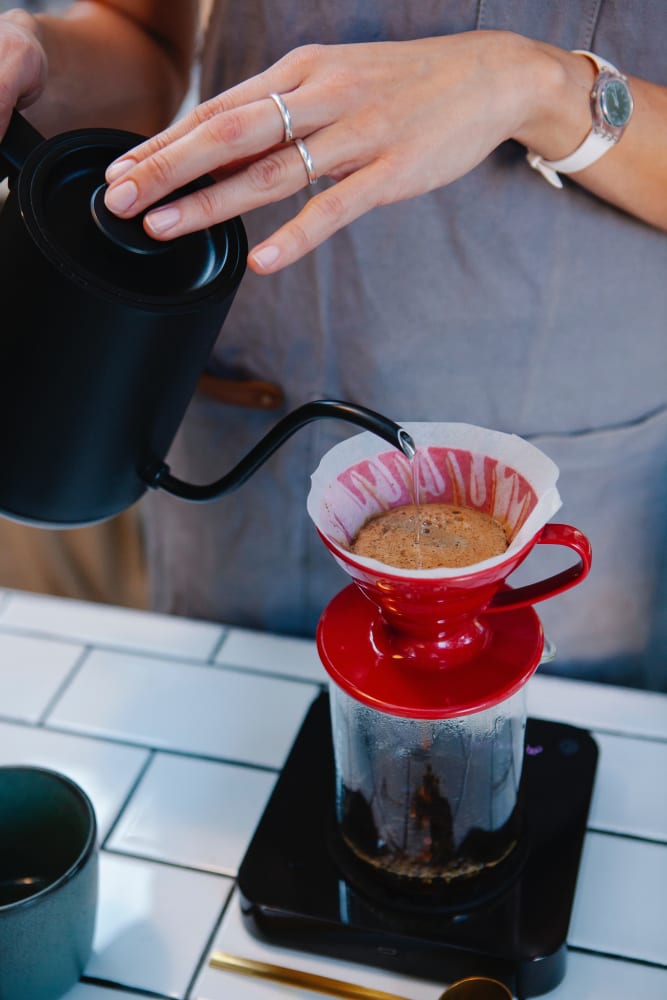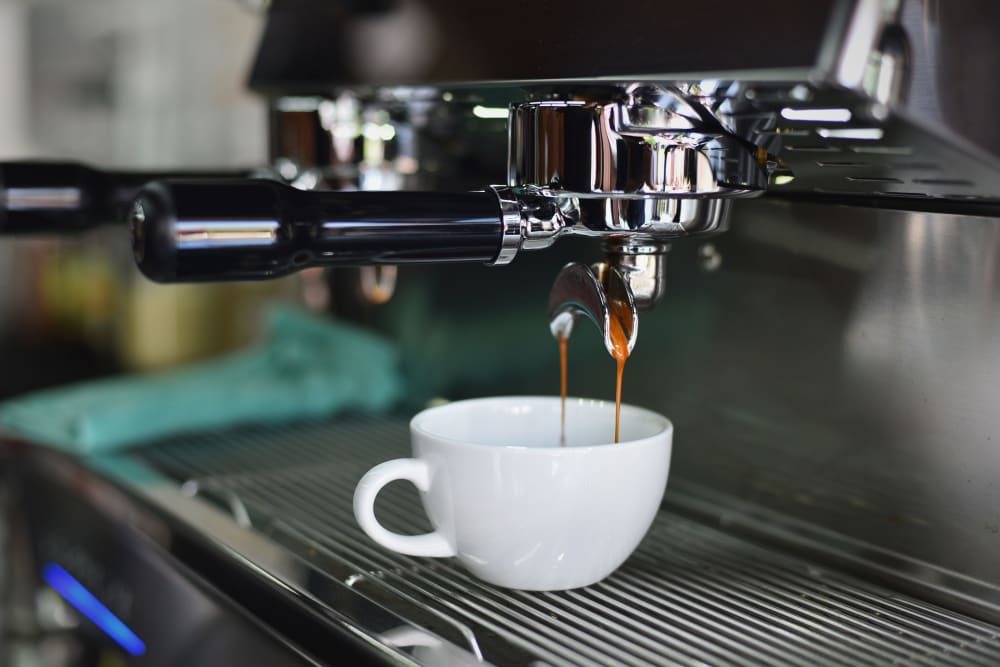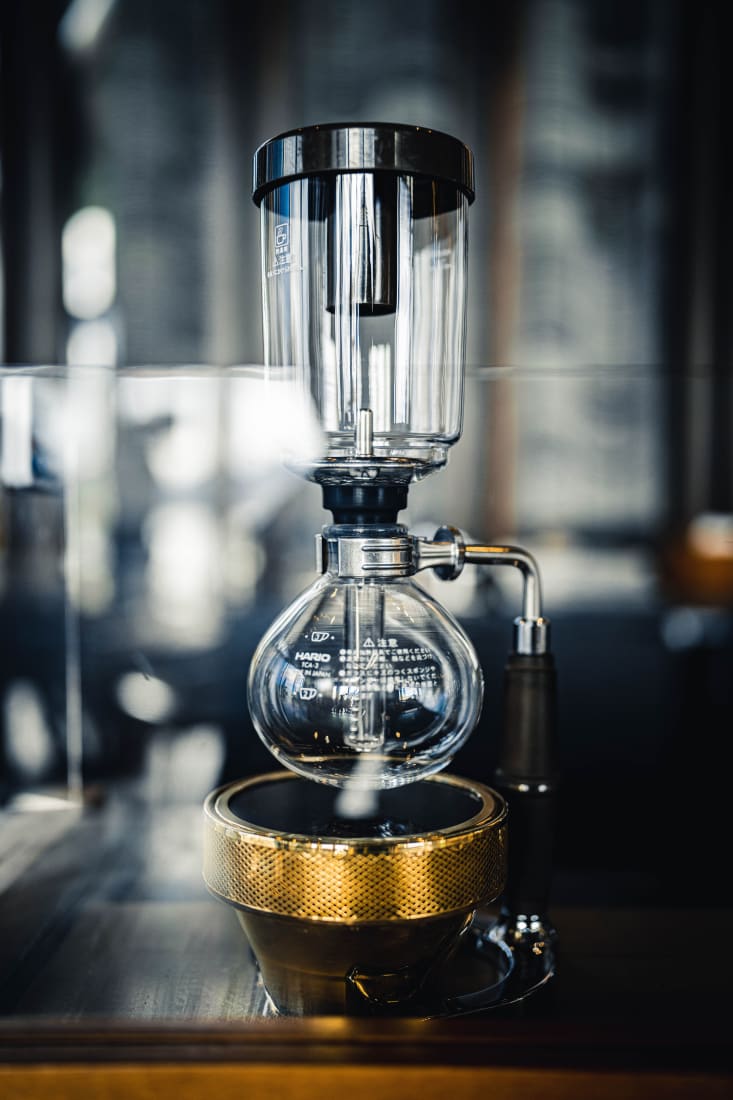There are many ways to brew coffee and it is important to know how to do each technique properly; brewing is a key factor in how your coffee tastes.

Drip coffee machines are found all across the globe in homes, offices, and restaurants. They are perfect if you want a hot cup coffee with ease.
You place a filter into the machine, add your chosen grounds, and then fill the reservoir with water. The water flows through into an aluminum tube contained inside the heating element. Once you’ve clicked the “on” switch, the heating elements heat the tube, bringing the water to boiling point.
As the water boils, the bubbles created rise up a second tube. Small bubbles of boiling water flow into the drip area where the water is dispersed to drip evenly onto the grounds. The hot water passes over and through the coffee grounds, creating the delicious coffee, which then drips down into the waiting coffee pot that sits on a hotplate beneath.
Disposable coffee filters made of paper are probably the most common, as they tend to be pretty cheap and easy to obtain.
Unlike paper filters, a metal mesh structure won’t absorb any flavorful coffee oils; the more of these present in your cup, the more full-bodied your coffee will taste and smell!
Metal mesh filters are typically stainless steel or aluminum, however, look for gold plated filters because they do not leave a metallic after-taste. Metal filters are also great for environmental-friendliness, as they can last a lifetime if properly maintained; this means way less paper waste sitting in a landfill.

The pour-over coffee method is similar to the drip method, in that you saturate coffee grounds with water and collect the liquid as it passes through a filter. However, one of the main problems with the drip method is that you have little control over how the machine brews the coffee.
The pour-over method allows you to control the temperature of the water, the speed at which it goes into the grounds, the amount of time it brews and how much it makes. Coffee enthusiasts tend to prefer this method because it allows them to control the taste, texture, temperature and strength of the brew.
While there are several types of devices you can use to make pour-over coffee, the method remains the same:
Heat the water to your desired temperature — most people use a gooseneck kettle, as it helps control the flow of water.
Put the filter and coffee grounds in place — preferably fresh-ground.
Add enough hot water to wet all the coffee grounds.
Stop pouring and wait for about 30 seconds.
Continue pouring the water over the grounds at a slow and consistent rate.
Stop when you've produced the desired amount of coffee.
Since this process is entirely manual, you can control almost every aspect of the process. If you want a fuller flavor, you can let the water sit longer in the grounds. If you want it weaker, you can alter the ratio by using more water or fewer beans. If you want a hotter drink, you can start with a higher water temperature. Nearly every step is customizable, so you can make each cup customized to your taste.
However, this method also allows more room for error. Unless you're diligent with your measurements and ratios, you'll have trouble creating the same result twice. Even a minor variation in the recipe can completely change the taste.

As opposed to drip machines that only pass the water through the coffee and a filter, the French press, also known as a press pot, actually brews the coffee with the hot water. Then, a metal filter is pressed inside the pot and it traps all the coffee grinds. This method leaves the coffees oils and rich tastes and aromas.
With the French press, you have a lot of control. You can make the temperature of the water much hotter, it should be around 190 to 200 degrees Fahrenheit, a temperature that most drip makers can not reach. You can also control the amount of coffee you want to add to make it stronger, and also the brew time, which should be about 4 minutes on average.
The French press is also extremely portable; you do not need electricity or lots of space, just hot water. An important tip to remember is to take out the coffee; do not leave it in with the grounds after it is brewed.

The Moka pot is designed to make a few small cups of very strong coffee, like an espresso.
A Moka pot is usually made of either aluminum or stainless steel. Aluminum is cheaper, but stainless steel is stronger and more durable.
The Moka pot is made up of three units:
A lower chamber – a well for holding water.
A filter basket – for holding the ground coffee.
An upper chamber – where the final brew will accumulate.
Water is added to the lower chamber and heated on a stovetop. The water turns to steam as it reaches boiling point, and pressure builds up in the lower chamber. This pressure forces the heated water through a funnel and into the filter-basket, which houses the ground coffee.
Then the coffee granules begin to absorb the water. Pressure builds up as the coffee becomes fully saturated, and the blend is then forced through another funnel that leads into the upper chamber.
Two metal filters prevent coffee granules from moving into the lower and upper chambers, so only the liquid is filtered into the upper chamber. Most Moka pots also feature a safety pressure release valve on the lower chamber.

There are two types of espresso machines: automatic and semi-automatic. The difference lies in how hands-on these machines are. They both require basic maintenance and cleaning procedures to ensure the long life and consistent results you expect from buying an espresso machine.
These are easy to use. You are only required to measure the coffee grounds and water and put them in their correct reservoirs, along with tamping (packing) the grounds. You press a button that handles everything else. There is an internal timer that stops the extraction, and in 25-30 seconds, you have quality espresso waiting for you.
These are an even more authentic and hands-on option for someone looking for a challenge. They do less of the work for you and allow you to learn more about the craft of espresso making. You have to take the same steps as the automatic version, but you control the length of the shot. This is the big difference between a semi-automatic and an automatic model.

Like the french press, vacuum brewers make the coffee together with the hot water. However, these devices are not very common and can be hard to find.
A vacuum brewer has an upper and a lower chamber connected by a thin tube with a small filter inside.
Ground coffee is placed in the upper chamber, and water is placed in the lower. As the pot is heated, the water slowly rises up to meet the coffee in the upper chamber and begins to brew. Finally, the water is cooled and the coffee seeps back into the lower chamber through the tube, leaving the grounds behind. The top chamber is removed, and you can serve the coffee. These can be electric or stovetop.

The toddy maker is an uncommon tool, which uses a cold-brewing method that creates a coffee concentrate. This concentrate is then mixed with hot water to make coffee.
The concentrate can be refrigerated and used to make a cup of coffee at a time, whenever you desire. This method is exceptional for coffee drinkers with stomach problems because the resulting coffee is very low-acid.
However, this method does take a great deal of time because the water is cold. Plan to brew over night for multiple cups of great tasting coffee!

All third party trademarks (including logos, names, etc.) remain property of their respective owners. Enjoy Better Coffee's use of these trademarks does not imply any endoresment or affiliation with the holder. Any references by Enjoy Better Coffee is to identify corresponding third party goods and/or services and shall be considered nominative fair use under trademark law. Photos are for illustrative purposes only, packaging may vary.